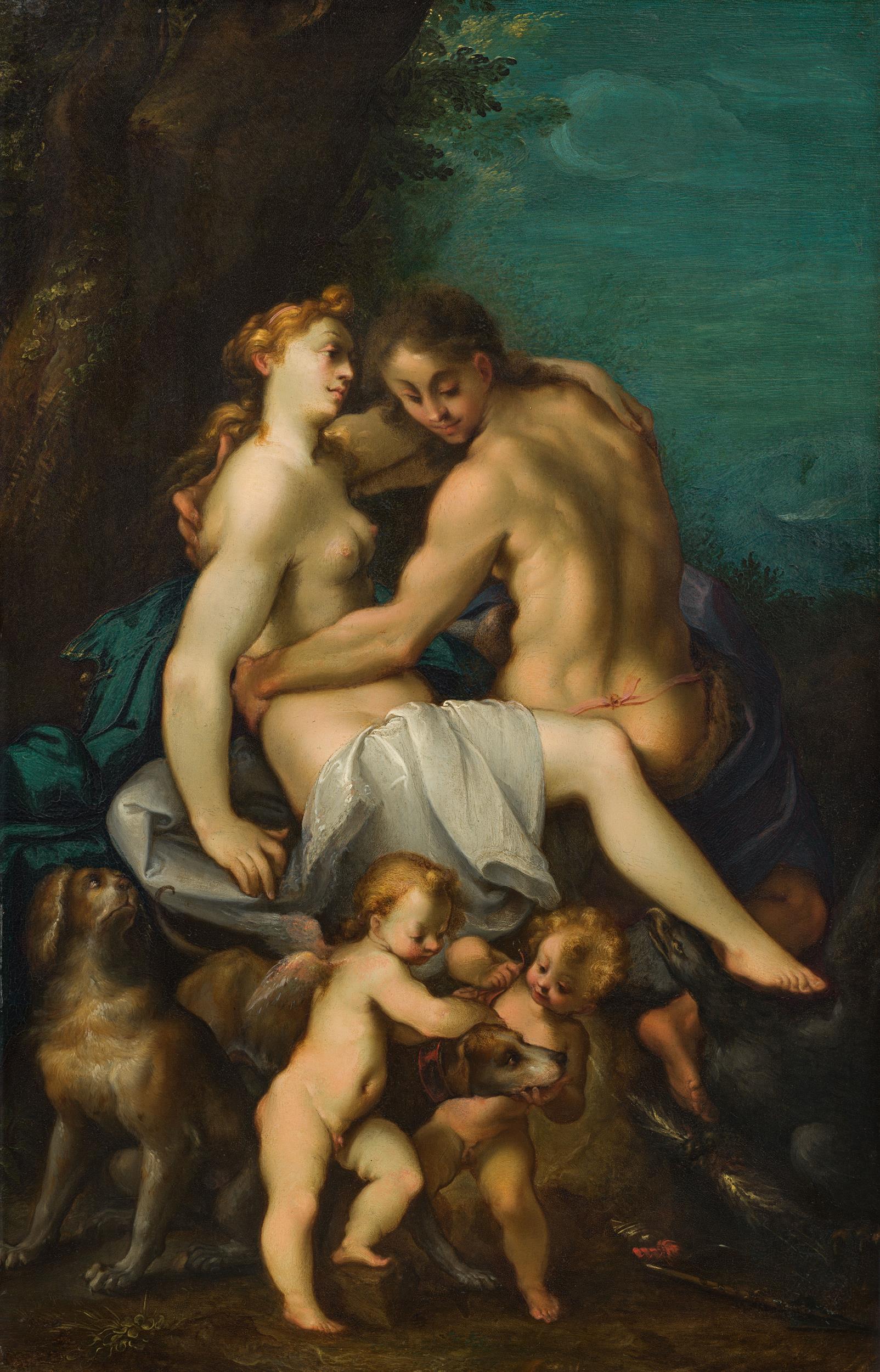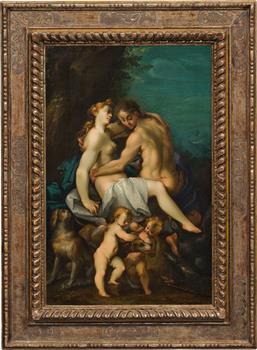2084
„Zeus and Callisto“
oil on copper; framed
48 x 31 cm
on the reverse an only fragmentarily preserved inscription (probably 17th century)
Provenance
Dorotheum, Vienna, 4 Dezember 1973, lot 58 (as Joseph Heintz d.Ä.);
since then private property, Vienna
Literature
Jürgen Zimmer, Joseph Heintz der Ältere. Neue Ergebnisse zum Werk des Malers, in: Alte und moderne Kunst XXIV, issue 163, Vienna 1979, p. 11f., SW-ill. 6, (attributed to Matthäus Gundelach);
Thomas DaCosta Kaufmann, The School of Prague. Painting at the Court of Rudolf II, Chicago/London 1985, p. 196 (mentioned under no. 7.43);
Prag um 1600. Kunst und Kultur am Hofe Kaiser Rudolfs II. (exhibition catalogue, Kunsthistorisches Museum, Vienna 1988/1989), ed. 2, Freren 1988, p. 89f. (mentioned under no. 559)
Estimate: € 180.000 - 360.000
Hammer price: € 200.000*
under reserve, Reserve Price: € 250.000
Auction is closed.
The composition of the present painting corresponds to Joseph Heintz the Elder's (1564-1609) famous work Zeus and Callisto, which is now in the Kunsthistorisches Museum in Vienna (40 x 31.7 cm, oil on copper, inv. no. GG 1105). It was probably already in the collection of the Prague Kunstkammer of Emperor Rudolf II (1552-1612), but can only be traced back to the gallery from 1781. In the past, the depiction was interpreted as "Venus and Adonis" due to the frequency of the theme at the Rudolfine court, but could be identified as "Zeus and Callisto" in recent decades on the basis of the added attributes. The eagle and the bundle of lightning at the right edge of the picture testify to the fact that this is the story of one of the love affairs of the father of the gods. He approached the nymph Callisto in the form of the goddess of hunting Artemis, whose muscular androgynous body is presented to the viewer only in the slightly rotated back view and in contrast to the nymph appearing with feminine curves. The bow and arrow in the lower right corner and the two hunting dogs also refer to the goddess of hunting.
The putti in the foreground seem to be inspired by Parmigianino's "Cupid carving his Bow" (KHM, Inv.-No. GG 275), a painting which Rudolf II acquired in 1503 and which was also copied shortly afterwards by Joseph Heintz the Elder (KHM, Inv.-No. GG 1588). This not only testifies to the common practice of copying, repetition and variation among the artists at the Rudolfine court, but also explains the dating of the composition of Zeus and Callisto shortly after 1603, i.e. close to the date of Leda, dated 1605, in which Zeus approaches the king's daughter in the form of a swan. The latter work was also listed in the Rudolfine inventories, but was sold to an Antwerp art dealer in 1623 and was only recently rediscovered in private German ownership (cf. exhibition catalogue Augsburg, Schaetzlerpalais: Die verschollene Leda, Joseph Heintz the Elder, Augsburg Citizen and Imperial Court Painter, Berlin/ Munich 2015).
When it was acquired in 1973, this copper plate was considered to be an original variant of the painting by Joseph Heintz the Elder and has now been in private hands for 50 years. Since then it has been mentioned several times as a contemporary copy in the literature and exhibition catalogues on the work in the Kunsthistorisches Museum (cf. The School of Prague 1985 or Prag um 1600, 1988). As early as 1979, Dr. Jürgen Zimmer published the painting and suggested a possible attribution to Matthäus Gundelach (1566-1653): „Die Heintzsche Darstellung ist im Wesentlichen sehr getreu wiederholt, ja sogar ist Gundelach auf seine Handschrift eingegangen, jedoch ist das Format etwas mehr in die Höhe gestreckt, so dass die Landschaft einen größeren Raum einnimmt. Außerdem fehlt der Lorbeerkranz, den Venus auf der Heintzschen Vorlage trägt. Die Wiederholung dürfte der mittleren Prager Zeit Gundelachs angehören und etwa zwischen 1605 und 1613 entstanden sein. Damals stand der Maler unter dem starken Einfluß des Heintz, das jedenfalls lässt sich noch an seinem 1613 datierten Bild ‚Amor und Psyche‘ der Bayerischen Staatsgemäldesammlungen (…) ablesen“ ("Heintz's depiction is essentially very faithfully repeated, indeed Gundelach has even gone into his handwriting, but the format is somewhat more stretched upwards, so that the landscape occupies a larger space. In addition, the laurel wreath that Venus wears in Heintz's original is missing. The repetition probably belongs to Gundelach's mid-Prague period and was painted between 1605 and 1613. At that time the painter was under the strong influence of Heintz, which at any rate can still be seen in his painting 'Amor und Psyche' of the Bayerische Staatsgemäldesammlungen (...), dated 1613"( (Zimmer 1979, p. 11f.).
There was a close artistic relationship between Joseph Heintz the Elder and Matthäus Gundelach, who was roughly the same age. Heintz, also active in Augsburg, was court painter to Rudolf II from 1591 and from 1593 Gundelach is also documented in the circle of imperial artists in Prague - possibly initially working in the studio of Bartholomäus Spranger (1546-1611). In 1509, after the death of Joseph Heintz, Gundelach succeeded him as imperial court painter. „Zudem hatte er 1610 die Witwe von Joseph Heintz d. Ä. geheiratet, damit vermutlich dessen Haus und Werkstatt übernommen und die unvollendet gebliebenen Arbeiten seines Vorgängers fertiggestellt, mit dem er in den Jahren zuvor wohl eng zusammengearbeitet hatte.“ ("In addition, he had married the widow of Joseph Heintz the Elder in 1610, thus presumably taking over his house and workshop and completing the unfinished works of his predecessor, with whom he had probably worked closely in the years before.") (Die Deutsche Barock Galerie im Schaezlerpalais. Meisterwerke der Augsburger Sammlung, Berlin/Munich 2016, p. 160, no. 40).
The inscription on the reverse of the copper plate, which probably dates from the 17th century, could possibly have provided more detailed information on the exact circumstances of the painting's origin and history, but unfortunately only fragments remain today. The artistic quality of the details and glazes, however, testifies to the masterly craftsmanship of the inner circle of the artistic elite gathered at the Prague court. The term "Prague around 1600", which has become a style-defining term, today represents not only the political capital of the empire at the time, but above all the unique intellectual and artistic centre that Rudolf II had created around himself, which only lasted for a few decades.


